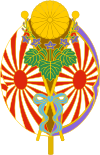| Kaigun-gensui 海軍元帥 | |
|---|---|
 Gensui Badge | |
| Country | |
| Service branch | |
| Formation | 20 January 1898 |
| Abolished | 1945 |
| Next higher rank | Dai-gensui |
| Next lower rank | Admiral |
| Equivalent ranks | Gensui (Army) |
Kaigun-gensui (海軍元帥, Marshal of the Navy), formal rank designations: Gensui-kaigun-taishō (元帥海軍大将, Marshal-admiral) was the highest rank in the Imperial Japanese Navy. The term gensui was used for both the navy and the Imperial Japanese Army, and was a largely honorific title awarded for extremely meritorious service to the Emperor. In the Meiji period, the title was awarded to five generals and three admirals. In the Taishō period it was awarded to six generals and six admirals, and in the Shōwa period it was awarded to six generals and four admirals. It was similar to Admiral of the Fleet in the Royal Navy and Fleet admiral in the United States Navy.
YouTube Encyclopedic
-
1/3Views:8402 2833 466
-
Destoyer-Escorts of the Imperial Japanese Navy: Part 2
-
1930s SILENT JAPANESE NEWSREEL TRIBUTE TO FLEET ADMIRAL HEIHACHIRO TOGO HERO OF TSUSHIMA 42084
-
Highest military ranks
Transcription
List of Kaigun-gensui
Note that several were promoted the same year they died; these were posthumous promotions.
| Portrait | Name (Birth–Death) |
Appointed | Retired | Origin | Ref. |
|---|---|---|---|---|---|

|
Marquess Saigō Tsugumichi (1843–1902) |
20 January 1898 | 1898 | Kagoshima | |

|
Count Itō Sukeyuki (1843–1914) |
31 January 1906 | 16 January 1914 † | ||

|
Viscount Inoue Yoshika (1845–1929) |
31 October 1911 | 22 March 1929 † | ||

|
Marquess Tōgō Heihachirō (1847–1934) |
21 April 1913 | 30 May 1934 † | ||

|
Prince Arisugawa Takehito (1862–1913) |
7 July 1913 | 10 July 1913 † | Imperial Family | |

|
Baron Ijūin Gorō (1852–1921) |
26 May 1917 | 13 January 1921 † | Kagoshima | |

|
Prince Higashifushimi Yorihito (1867–1922) |
27 June 1922 (posthumous) |
Imperial Family | ||

|
Baron Shimamura Hayao (1858–1923) |
8 January 1923 (posthumous) |
Kōchi | ||

|
Baron Katō Tomosaburō (1861–1923) |
23 August 1923 | 24 August 1923 † | Hiroshima | |

|
Prince Fushimi Hiroyasu (1876–1946) |
27 May 1932 | 1945 | Imperial Family | |

|
Yamamoto Isoroku (1884–1943) |
18 April 1943 (posthumous) |
Nagaoka | ||

|
Nagano Osami (1880–1947) |
21 June 1943 | 1945 | Kōchi | |

|
Koga Mineichi (1885–1944) |
31 March 1944 (posthumous) |
Arita | ||
